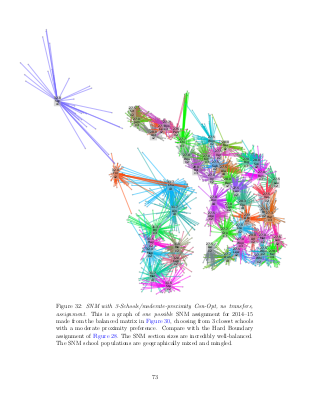2016-03-08: Let's spice things up a bit
Let's spice things up a bit now! Here is an example of a Soft Neighborhood Model assignment for the kindergarten class of 2014-15:
In this "3-School Moderate SNM", each student is assigned to one of the three closest schools to her house, with a moderate weight towards the closer schools. As in our previous two posts, this assignment disallows transfers and cross-river assignments, and uses "optimal section counts" based on PPS's assessment of actual building capacities. Distances between home and school are routed by-car distances.
Remember how inconsistent the section sizes were with both Hard Boundaries and Single Closest School? The Soft Neighborhood Model consistently fills sections as close as possible to the ideal/average section size (27.5 on the East side and 31.6 on the West side). On the East side, all section sizes range between and 27.0 and 29.0. On the West side, they range between 31.0 and 32.0. The SNM nails enrollment balancing.
But, it does more than that: it actively counters socio-economic stratification. Instead of being isolated blobs of color, the schools' populations overlap geographically. And picking an address no longer guarantees assignment to a specific school. This flips the dynamics of school assignment, by reducing the power to differentiate families by what schools they attend.
Keep in mind that SNM assignments are ultimately random. This graph shows just one of many possible assignments that all yield the same balanced section sizes at each school. To demonstrate this, our SNM paper shows several more sample assignments for the same "3-School Moderate SNM."
SNM enrollment balancing happens at the section and grade level. This is how PPS can make maximally-efficient use of the limited capacity it currently has in its building stock, in the face of a growing population, constrained funding, and limited real estate. Furthermore, balancing enrollments at the grade level, not the school level, and providing predictable enrollment in every section of every school, builds a foundation for equitable programming.
Copyright 2016, Brooke Cowan and Matthew Marjanovic

